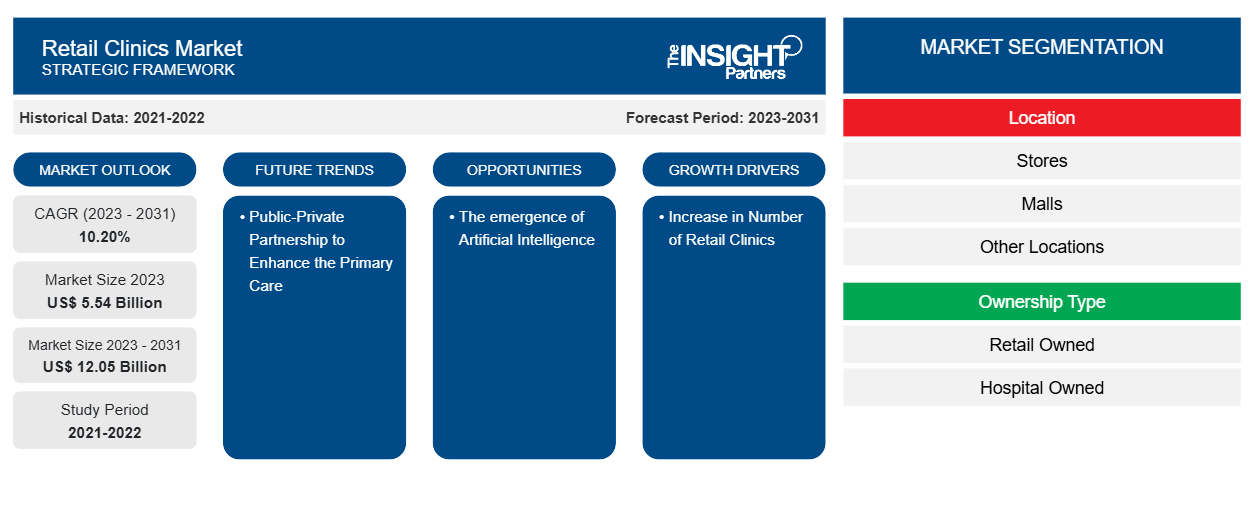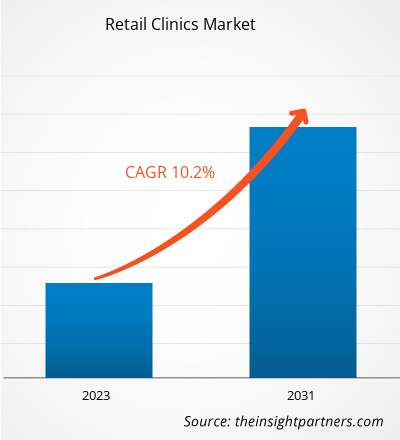The retail clinics market size is projected to reach US$ 12.05 billion by 2031 from US$ 5.54 billion in 2023. The market is expected to register a CAGR of 10.20% in 2023–2031. The emergence of artificial intelligence is likely to remain a key retail clinics market trend.
Retail Clinics Market Analysis
Retail clinics have been suggested as a cheaper alternative to emergency department care for non-emergency conditions. Up to 20 percent of ER visits for non-emergency settings are considered appropriate for retail clinics or urgent care facilities, potentially saving up to US$ 4.4 billion a year in costs. In the healthcare industry, retail clinics are becoming more and more critical. Transparent pricing and accessibility after hours are the main factors influencing growth.
Retail Clinics Market Overview
The application of artificial intelligence (AI) in healthcare—including retail clinics—is growing. AI can help with appointment scheduling, patient triage, and clinician decision support. Clinics can improve patient satisfaction, cut down on administrative burdens, and streamline operations with the use of this technology. In response to changing healthcare needs, retail clinics are starting to provide more specialized services like managing chronic diseases and mental health support. The factors mentioned above are influences the growth of the retail clinics market
Customize This Report To Suit Your Requirement
You will get customization on any report - free of charge - including parts of this report, or country-level analysis, Excel Data pack, as well as avail great offers and discounts for start-ups & universities
Retail Clinics Market: Strategic Insights

-
Get Top Key Market Trends of this report.This FREE sample will include data analysis, ranging from market trends to estimates and forecasts.
Retail Clinics Market Drivers and Opportunities
Increase in Number of Retail Clinics Favors Market
The patient-centered medical home is gaining popularity as a means of offering comprehensive, well-managed primary care. The quantity of retail clinics has significantly expanded concurrently. Growing support has been shown for the patient-centered medical home to better coordinate care, enhance quality, save costs, and bring new life to primary care. The number of retail clinics that provide accessible care for minor acute illnesses has increased dramatically, and the medical home concept has gained popularity. Thus, an increase in the popularity of retail clinics leads to an increase in the number of clinics, thereby driving market growth. For instance, according to Definitive Healthcare, LLC., as of March 2023, 1,801 operational retail clinics were spread across 44 states. The Midwest (27.7%) and Southeast (34.1%) are home to most retail clinics in the United States. There are the fewest retail clinics in the West (9.5%).
Public-Private Partnership to Enhance the Primary Care – An Opportunity in Retail Clinics Market
Municipalities and state governments can enhance access to primary care and promote economic development by partnering with retailers and retail clinics through public-private partnerships. For instance, in February 2024, through the Rapid Response Partnership Vehicle (RRPV), BARDA announced a new Project NextGen partnership opportunity aimed at facilitating better vaccine correlate of protection (CoP) data collection and expediting decentralized clinical trial (DCT) solutions. BARDA is seeking a partner for its first clinical study, which will only be carried out in a retail clinic or pharmacy setting.
Retail Clinics Market Report Segmentation Analysis
Key segments that contributed to the derivation of the retail clinics market analysis are location, ownership type, and application.
- Based on location, the retail clinics market is divided into stores, malls, other locations. The stores segment held a larger market share in 2023.
- Based on ownership type, the market is segmented into retail owned, hospital owned.
- In terms of application, the market is segmented into clinical chemistry & immunoassay, point of care diagnostics, vaccination, and other applications.
Retail Clinics Market Share Analysis by Geography
The geographic scope of the retail clinics market report is mainly divided into five regions: North America, Asia Pacific, Europe, Middle East & Africa, and South America/South & Central America.
In North America, the retail clinics market is currently in the growth phase and experiencing exponential growth. The US dominated the market in 2023 due to retail clinics' increasing popularity and availability. For instance, CVS, Walgreens, and Walmart are the primary retail clinics available in US. Six groups control ninety percent of retail clinics. With more than half of all retail clinic sites, the nation's most prominent player is the pharmacy giant CVS. The business, which also owns a pharmacy benefits manager (Caremark) and payer (Aetna), entered the retail clinic industry in 2006 when it purchased MinuteClinic, formerly QuickMedx.
Retail Clinics Market Regional Insights
The regional trends and factors influencing the Retail Clinics Market throughout the forecast period have been thoroughly explained by the analysts at The Insight Partners. This section also discusses Retail Clinics Market segments and geography across North America, Europe, Asia Pacific, Middle East and Africa, and South and Central America.
Retail Clinics Market Report Scope
| Report Attribute | Details |
|---|---|
| Market size in 2023 | US$ 5.54 Billion |
| Market Size by 2031 | US$ 12.05 Billion |
| Global CAGR (2023 - 2031) | 10.20% |
| Historical Data | 2021-2022 |
| Forecast period | 2023-2031 |
| Segments Covered |
By Location
|
| Regions and Countries Covered |
North America
|
| Market leaders and key company profiles |
|
Retail Clinics Market Players Density: Understanding Its Impact on Business Dynamics
The Retail Clinics Market is growing rapidly, driven by increasing end-user demand due to factors such as evolving consumer preferences, technological advancements, and greater awareness of the product's benefits. As demand rises, businesses are expanding their offerings, innovating to meet consumer needs, and capitalizing on emerging trends, which further fuels market growth.

- Get the Retail Clinics Market top key players overview
Retail Clinics Market News and Recent Developments
The retail clinics market is evaluated by gathering qualitative and quantitative data post primary and secondary research, which includes important corporate publications, association data, and databases. The following is a list of developments in the market for innovations, business expansion, and strategies:
- In October 2023, Walgreens and Hartford HealthCare add health clinics to select Walgreens locations in Connecticut, advancing a unique retail health model based on convenience, access to care, affordability and health equity. This is Walgreens first retail clinic collaboration with a health system in New England. (Source: Hartford HealthCare, Press Release)
Retail Clinics Market Report Coverage and Deliverables
The “Retail Clinics Market Size and Forecast (2021–2031)” report provides a detailed analysis of the market covering the following areas:
Retail Clinics Market size and forecast at global, regional, and country levels for all the key market segments covered under the scope
- Market dynamics such as drivers, restraints, and key opportunities
Retail Clinics Market trends
- Detailed PEST/Porter’s Five Forces and SWOT analysis
Retail Clinics market analysis covering key market trends, Global and regional framework, major players, regulations, and recent market developments
Retail Clinics Industry landscape and competition analysis covering market concentration, heat map analysis, prominent players, and recent developments
- Detailed company profiles
Frequently Asked Questions
Which region dominated the retail clinics market in 2023?
What are the driving factors impacting the retail clinics market?
What are the future trends of the retail clinics market?
Which are the leading players operating in the retail clinics market?
What is the expected CAGR of the retail clinics market?
- Historical Analysis (2 Years), Base Year, Forecast (7 Years) with CAGR
- PEST and SWOT Analysis
- Market Size Value / Volume - Global, Regional, Country
- Industry and Competitive Landscape
- Excel Dataset
Recent Reports
Testimonials
Reason to Buy
- Informed Decision-Making
- Understanding Market Dynamics
- Competitive Analysis
- Identifying Emerging Markets
- Customer Insights
- Market Forecasts
- Risk Mitigation
- Boosting Operational Efficiency
- Strategic Planning
- Investment Justification
- Tracking Industry Innovations
- Aligning with Regulatory Trends





















 Get Free Sample For
Get Free Sample For